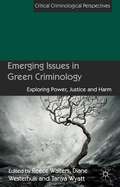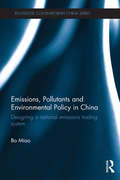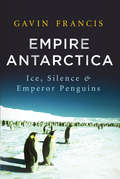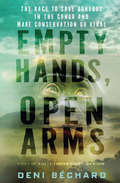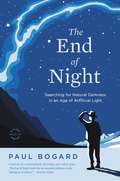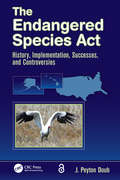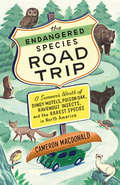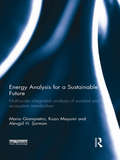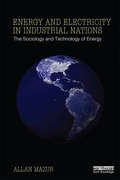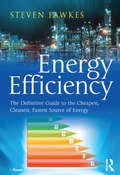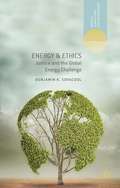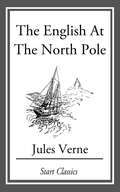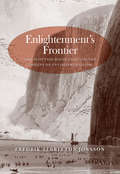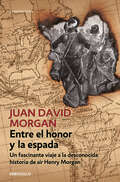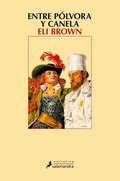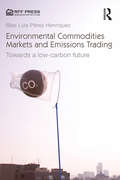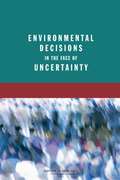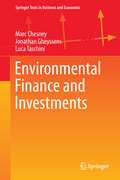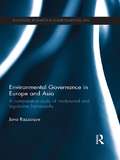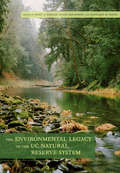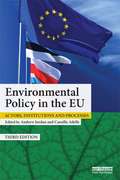- Table View
- List View
Emerging Issues in Green Criminology
by Reece Walters Diane Solomon Westerhuis Tanya WyattThis edited collection brings together internationally renowned scholars to explore green criminology through the interdisciplinary lenses of power, harm and justice. The chapters provide innovative case study analyses from around the world that seek to advance theoretical, policy and practice discourses about environmental harm.
Emissions, Pollutants and Environmental Policy in China: Designing a National Emissions Trading System (Routledge Contemporary China Series)
by Bo MiaoAs the world's biggest polluter, the environmental challenges that China faces in controlling its airborne emissions are crucial, not only to its own population in terms of tackling the severe domestic air pollution, but also to the planet as it faces calls from the international community to accept its responsibilities in cutting greenhouse gases. Deteriorating air quality clearly shows that China’s current environmental regime is unsuited to either tackle the rampant domestic air pollution or contribute fairly to international climate action. As such, this book explores the feasibility of applying a national emissions trading system to control multiple air pollutants in China. It begins with an outline of the existing emissions management system and goes onto explore whether a national emissions trading system is a viable choice to combat China’s conventional air pollutants. To this end, there is an in-depth analysis of the two pilot sulphur dioxide emissions trading programs in Taiyuan and Jiangsu, as well as an examination of emissions trading schemes in the US and EU. Finally, the book discusses the key design elements of a multi-pollutant cap-and-trade scheme that addresses both conventional air pollutants and greenhouse gasses. This book will be of great interest to students and scholars interested in the fields of environmental studies, Chinese politics and environmental law. It will also be invaluable to policy makers in the field.
Empire Antarctica: Ice, Silence & Emperor Penguins
by Gavin FrancisGavin Francis fulfilled a lifetime's ambition when he spent fourteen months as the basecamp doctor at Halley, a profoundly isolated British research station on the Caird Coast of Antarctica. So remote, it is said to be easier to evacuate a casualty from the International Space Station than it is to bring someone out of Halley in winter.Antarctica offered a year of unparalleled silence and solitude, with few distractions and a very little human history, but also a rare opportunity to live among emperor penguins, the only species truly at home in he Antarctic. Following Penguins throughout the year -- from a summer of perpetual sunshine to months of winter darkness -- Gavin Francis explores the world of great beauty conjured from the simplest of elements, the hardship of living at 50 c below zero and the unexpected comfort that the penguin community bring.Empire Antarctica is the story of one man and his fascination with the world's loneliest continent, as well as the emperor penguins who weather the winter with him. Combining an evocative narrative with a sublime sensitivity to the natural world, this is travel writing at its very best
Empty Hands, Open Arms: The Race to Save Bonobos in the Congo and Make Conservation Go Viral
by Deni BéchardWhen acclaimed author Deni Béchard first learned of the last living bonobos-matriarchal great apes that are, alongside the chimpanzee, our closest relatives in the animal kingdom-he was completely astonished. How could the world possibly accept the extinction of this majestic species?Béchard discovered one relatively small NGO, the Bonobo Conservation Initiative (BCI), which has done more to save bonobos than many far larger organizations. Based on the author's extensive travels in the Congo and Rwanda, this book explores BCI's success, offering a powerful, truly postcolonial model of conservation. In contrast to other traditional conservation groups Béchard finds, BCI works closely with Congolese communities, addressing the underlying problems of poverty and unemployment, which lead to the hunting of bonobos. By creating jobs and building schools, they gradually change the conditions that lead to the eradication of the bonobos.This struggle is far from easy. Devastated by the worst military conflict since World War II, the Congo and its forests continue to be destroyed by aggressive logging and mining. Béchard's fascinating and moving account-filled with portraits of the extraordinary individuals and communities who make it all happen offers a rich example of how international conservation must be reinvented before it's too late.
The End of Night: Searching for Natural Darkness in an Age of Artificial Light
by Paul BogardA deeply panoramic tour of the night, from its brightest spots to the darkest skies we have left. A starry night is one of nature's most magical wonders. Yet in our artificially lit world, three-quarters of Americans' eyes never switch to night vision and most of us no longer experience true darkness. In THE END OF NIGHT, Paul Bogard restores our awareness of the spectacularly primal, wildly dark night sky and how it has influenced the human experience across everything from science to art. From Las Vegas' Luxor Beam--the brightest single spot on this planet--to nights so starlit the sky looks like snow, Bogard blends personal narrative, natural history, science, and history to shed light on the importance of darkness--what we've lost, what we still have, and what we might regain--and the simple ways we can reduce the brightness of our nights tonight.
The Endangered Species Act: History, Implementation, Successes, and Controversies
by J. Peyton DoubThe complex regulations of the Endangered Species Act can be challenging for environmental professionals who must comply with them or assist clients in compliance. This volume discusses the Act using clear scientific prose that all professionals can readily comprehend. It explores the history and the basic scientific theory underlying the Act. It provides an overview of its key provisions and examines the Act in the context of other key environmental planning statutes. The book also details the regulatory processes faced by other government agencies and private developers who must routinely ensure that their actions are in compliance.
The Endangered Species Road Trip
by Cameron MacdonaldBill Bryson meets John Vaillant in this life list quest to see the rarest species in North America.Crammed into a minivan with wife, toddler, infant, and dog, accompanied by mounds of toys, diapers, tent, sleeping bags, and other paraphernalia, Cameron MacDonald embarks on a road trip of a lifetime to observe North America's rarest species. In California, the family camps in the brutally hot Mojave, where he observes a desert tortoise-"the size and shape of a bike helmet and the colour of gravel" sitting motionless in the shade of a scrubby sagebush. In Yellowstone, after driving through unseasonal snow, he manages to spot a rare black wolf and numerous grizzlies, which, unfortunately, call forth a crowd of "grizzly gawkers." The journey takes the MacDonald family from British Columbia, along the west coast of the U.S., through the Southwest and Florida, up the east coast of the U.S., and finally to eastern Canada and then back home to BC.Along the way, MacDonald offers fascinating details about the natural history of the endangered species he seeks, as well as threats like overpopulation, commercial fishing, and climate change that are driving them towards extinction.
Endemism in Vascular Plants
by Carsten HobohmThe book is the first comprehensive analysis of the macroecology and geobotany of endemic vascular plants with case-studies and analyses from different regions in the world. Endemism is a pre-extinction phenomenon. Endemics are threatened with extinction. Due to international nature conservation policies and due to the perception of the public the concept's importance is increasing. Endemism can result from different biological and environmental processes. Depending on the process conservation measures should be adapted. Endemic vascular plant taxa, in the setting of their species composition and vegetation types are important features of landscapes and indicators of the quality of relating habitats. The book is an important basis for biologists, ecologists, geographers, planners and managers of nature reserves and national parks, and people generally interested in nature conservation and biogeography of vascular plants.
Energy Analysis for a Sustainable Future: Multi-Scale Integrated Analysis of Societal and Ecosystem Metabolism
by Mario Giampietro Kozo Mayumi Alevgül H. ŞormanThe vast majority of the countries of the world are now facing an imminent energy crisis, particularly the USA, China, India, Japan and EU countries, but also developing countries having to boost their economic growth precisely when more powerful economies will prevent them from using the limited supply of fossil energy. Despite this crisis, current protocols of energy accounting have been developed for dealing with fossil energy exclusively and are therefore not useful for the analysis of alternative energy sources. The first part of the book illustrates the weakness of existing analyses of energy problems: the science of energy was born and developed neglecting the issue of scale. The authors argue that it is necessary to adopt more complex protocols of accounting and analysis in order to generate robust energy scenarios and effective assessments of the quality of alternative energy sources. The second part of the book introduces the concept of energetic metabolism of modern societies and uses empirical results. The authors present an innovative approach – Multi-Scale Integrated Analysis of Societal and Ecosystem Metabolism (MuSIASEM) – capable of characterizing the quality of alternative energy sources in relation to both environmental constraints and socio-economic requirements. This method allows the metabolic pattern of a society to be described in relation to its feasibility, when looking at biophysical factors, and desirability, when looking at socio-economic factors.Addressing the issue of scale in energy analysis by cutting through the confusion found in current applications of energy analysis, this book should be of interest to researchers, students and policy makers in energy within a variety of disciplines.
Energy and Electricity in Industrial Nations: The Sociology and Technology of Energy
by Allan MazurEnergy is at the top of the list of environmental problems facing industrial society, and is arguably the one that has been handled least successfully, in part because politicians and the public do not understand the physical technologies, while the engineers and industrialists do not understand the societal forces in which they operate. In this book, Allan Mazur, an engineer and a sociologist, explains energy technologies for nontechnical readers and analyses the sociology of energy. The book gives an overview of energy policy in industrialised countries including analysis of climate change, the development of electricity, forms of renewable energy and public perception of the issues. Energy is a key component to environment policy and to the workings of industrial society. This novel approach to energy technology and policy makes the book an invaluable inter-disciplinary resource for students across a range of subjects, from environmental and engineering policy, to energy technology, public administration, and environmental sociology and economics.
Energy Efficiency: The Definitive Guide to the Cheapest, Cleanest, Fastest Source of Energy
by Steven FawkesEnergy risk has reappeared on the corporate and social agenda with a bang and the complexity of the issues has increased many-fold since the days of the last great wave of concern following the oil crises of the 1970s. Steven Fawkes’ Energy Efficiency is a comprehensive guide for managers and policy-makers to the fundamental questions underpinning energy-efficiency and our responses to it: ¢ what do we really mean by energy efficiency? ¢ what is the potential (in different dimensions)? ¢ why it is important? ¢ what management processes lead to optimisation of energy efficiency? ¢ what technologies are useful for improving energy efficiency? ¢ what policies can be used to promote energy efficiency? ¢ how can energy efficiency be financed? ¢ how can energy suppliers engage with energy efficiency? The result is the most comprehensive review to-date of the barriers and opportunities associated with improving energy efficiency. Clearly written and erudite, Steven Fawkes addresses every aspect of energy efficiency, including the huge and vitally important untapped potential offered by effective energy management and the application of existing technology. He also identifies barriers, such as the rebound effect and how they can be mitigated and he provides a comprehensive review of innovative energy efficiency financing options. This book is a ’must read’ for anyone with an interest in energy supply and demand reduction.
Energy & Ethics
by Benjamin K. SovacoolBenjamin K. Sovacool applies concepts from justice and ethics theory to contemporary energy problems, and illustrates particular solutions to those problems with examples and case studies from around the world.
The English at the North Pole
by Jules VerneThe English at the North Pole was originally published in 1864, being begun even before Verne's Journey to the Center of the Earth. This vigorous Arctic tale was used to found and introduce a "Magazine of Adventure,"which was continued for some years. The book contains an accurate picture of Arctic life and of the Arctic geography known to the world of 1864. The account of the Franklin expedition and of the persistent and heroic search for its relief is carefully studied and complete, only it necessarily fails to include the later investigations of the American expedition under Lieutenant Schwatka. These finally settled the last details of the historic tragedy.
Enlightenment's Frontier
by Dr Fredrik Albritton JonssonEnlightenment's Frontier is the first book to investigate the environmental roots of the Scottish Enlightenment. What was the place of the natural world in Adam Smith's famous defense of free trade? Fredrik Albritton Jonsson recovers the forgotten networks of improvers and natural historians that sought to transform the soil, plants, and climate of Scotland in the eighteenth century. The Highlands offered a vast outdoor laboratory for rival liberal and conservative views of nature and society. But when the improvement schemes foundered toward the end of the century, northern Scotland instead became a crucible for anxieties about overpopulation, resource exhaustion, and the physical limits to economic growth. In this way, the rise and fall of the Enlightenment in the Highlands sheds new light on the origins of environmentalism.
Entre el honor y la espada: Un fascinante viaje a la desconocida historia de sir Henry Morgan
by Juan David Morgan«–¿Queréis explicar a la Corte en qué consiste el oficio de privateer? –Un privateer es un soldado al servicio de la Corona inglesa que cobra su sueldo de los bienes incautados al enemigo.» En 1685 sir Henry Morgan, a quien cualquiera que no fuera súbdito de la Corona inglesa consideraría un vil pirata, demandó a dos reconocidos libreros de Londres y reclamó de cada uno de ellos la suma de diez mil libras esterlinas por daños a su honor. A través del juicio por difamación se narra la seductora vida del corsario Henry Morgan (1635- 1688), desde sus orígenes humildes en Llanrumney, país de Gales, hasta su ascenso a sir del Reino de Inglaterra, gracias a sus batallas en contra de la Corona española, escenificadas principalmente en el mar Caribe –Yucatán, Honduras, Nicaragua, Maracaibo, Portobelo– y, en especial, la toma y saqueo de Panamá en el Pacífico.
Entre pólvora y canela
by Eli BrownLa primera novela de piratas para gourmets. Una historia singular y trepidante, llena de aventuras marítimas y culinarias. En 1819, el Imperio británico domina los mares con mano de hierro y expande sus tentáculos hasta los confines del mundo. Ajeno a todo esto vive Owen Wedgwood, un cocinero magnífico que lleva casi una década a las órdenes de lord Ramsey, uno de los comerciantes más conspicuos de la época. Pero la plácida rutina del viudo y solitario Owen se trunca en un instante cuando, en el transcurso de un banquete, es secuestrado por los tripulantes del Flying Rose, un barco pirata al mando de la temible Hannah Mabbot, que lo encierra en las bodegas del navío y le anuncia que, si en algo aprecia su vida, deberá prepararle cada domingo una cena exquisita. Y si dicen que el instinto de supervivencia agudiza el ingenio, Owen lo demostrará con creces. Pesea disponer de una cocina sin utensilios adecuados y una despensa saqueada por las ratas, recurrirá a un sinfín de artimañas culinarias para servir a Mabbot deliciosos platos como paté de arenque al romero sobre pan de nueces o raviolis de anguila ahumada al té. Así, semana tras semana, mientras el cocinero lucha con denuedo por salvar su pellejo, entre él y la fiera capitana Mabbot va entablándose una improbable relación que puede acarrearle otro tipo de problemas. Sobre el telón de fondo del lado más oscuro del Imperio, con la trata de esclavos y los abusos vinculados al comercio del té, la seda y la plata, esta singular y trepidante historia gira en torno a dos personajes geniales: el pacato Owen Wedgwood, un Sherezade de los fogones que sufre una auténtica metamorfosis vital entre corsarios desalmados y vivencias al límite, y la insólita y fogosa Hannah Mabbot, cuyos secretos de familia la impulsan hacia un destino que bascula entre la gloria y el fracaso. Una explosiva amalgama de emocionantes aventuras marineras e inauditas experiencias gastronómicas que cautiva al lector desde la primera página. La crítica ha dicho...«Exuberancia gastronómica y aventuras de piratas vertiginosas son dos sabores que combinan de manera fantástica en este libro irresistible.»NPR «Sus sorprendentes personajes y las aventuras en alta mar hacen que esta novela sea muy distinta de cualquier otra que hayáis leído.»BookPage «Una novela histórica de capa y espada y de seducción culinaria, con personajes que evocan el desesperado ingenio de Sherezade y la endiablada crueldad del capitán Ahab.»Publishers Weekly «Intrépida y sensual.»Kirkus Reviews «Una combinación perfecta entre El festín de Babette y Piratas del Caribe.»Library Journal
Environmental Commodities Markets and Emissions Trading: Towards a Low-Carbon Future
by Blas Luis Pérez HenríquezMarket-based solutions to environmental problems offer great promise, but require complex public policies that take into account the many institutional factors necessary for the market to work and that guard against the social forces that can derail good public policies. Using insights about markets from the new institutional economics, this book sheds light on the institutional history of the emissions trading concept as it has evolved across different contexts. It makes accessible the policy design and practical implementation aspects of a key tool for fighting climate change: emissions trading systems (ETS) for environmental control. Blas Luis Pérez Henríquez analyzes past market-based environmental programs to extract lessons for the future of ETS. He follows the development of the emissions trading concept as it evolved in the United States and was later applied in the multinational European Emissions Trading System and in sub-national programs in the United States such as the Regional Greenhouse Gas Initiative (RGGI) and California’s ETS. This ex-post evaluation of an ETS as it evolves in real time in the real world provides a valuable supplement to what is already known from theoretical arguments and simulation studies about the advantages and disadvantages of the market strategy. Political cycles and political debate over the use of markets for environmental control make any form of climate policy extremely contentious. Pérez Henríquez argues that, despite ideological disagreements, the ETS approach, or, more popularly, 'cap-and-trade' policy design, remains the best hope for a cost-effective policy to reduce GHG emissions around the world.
Environmental Decisions in the Face of Uncertainty
by Committee on Decision Making Under Uncertainty Board on Population Health and Public Health Practice Institute of MedicineThe U.S. Environmental Protection Agency (EPA) is one of several federal agencies responsible for protecting Americans against significant risks to human health and the environment. As part of that mission, EPA estimates the nature, magnitude, and likelihood of risks to human health and the environment; identifies the potential regulatory actions that will mitigate those risks and protect public health1 and the environment; and uses that information to decide on appropriate regulatory action. Uncertainties, both qualitative and quantitative, in the data and analyses on which these decisions are based enter into the process at each step. As a result, the informed identification and use of the uncertainties inherent in the process is an essential feature of environmental decision making. EPA requested that the Institute of Medicine (IOM) convene a committee to provide guidance to its decision makers and their partners in states and localities on approaches to managing risk in different contexts when uncertainty is present. It also sought guidance on how information on uncertainty should be presented to help risk managers make sound decisions and to increase transparency in its communications with the public about those decisions. Given that its charge is not limited to human health risk assessment and includes broad questions about managing risks and decision making, in this report the committee examines the analysis of uncertainty in those other areas in addition to human health risks. Environmental Decisions in the Face of Uncertainty explains the statement of task and summarizes the findings of the committee.
Environmental Finance and Investments
by Jonathan Gheyssens Marc Chesney Luca TaschiniThe current economic and environmental situation poses fundamental questions that this book aims to answer: Under which conditions could a market-based approach contribute to a decrease in emissions? How are abatement and investment strategies generated or promoted under permit regimes like the European Union Emission Trading Scheme (EU ETS)? In the context of the EU ETS, what is the trade-off between production, technological changes and pollution? This book is intended to provide students and practitioners the knowledge and theoretical tools they need in order to answer these and other more general questions in the context of so-called environmental finance theory, a new field of research that investigates the economic, financial and managerial impacts of market-based environmental policies.
Environmental Governance in Europe and Asia: A Comparative Study of Institutional and Legislative Frameworks (Routledge Research in International Environmental Law)
by Jona RazzaqueThis book looks at environmental governance in both Asia and Europe and offers a comparative analysis of the two regions in order to provide a better understanding of the concept of ‘environmental governance’ and its status in Europe and Asia. The book assesses the legislative, institutional and participatory mechanisms which affect the overall development of environmental governance, and analyses current issues, concerns and strategies in respect of environmental governance at the local, national, and international levels. The rapid changes in economic, social and political life have had an enormous impact on Asia’s ecosystems and resources. Asian countries, in the name of economic development, are following the same environmentally destructive path their European counterparts followed in the past. The key to the environmental future of these two regions lies in the evolution of the character of governance - the ensemble of social ethics, public policies and institutions which structure how state actors and the civil society interact with the environment. This book will be valuable to scholars and students of environmental politics, EU and Asian studies, public policy, environmental law, and to decision makers and policy analysts.
An Environmental History of Russia
by Paul Josephson Nicolai Dronin Aleh Cherp Ruben Mnatsakanian Dmitry Efremenko Vladislav LarinThe former Soviet empire spanned eleven time zones and contained half the world's forests; vast deposits of oil, gas and coal; various ores; major rivers such as the Volga, Don and Angara; and extensive biodiversity. These resources and animals, as well as the people who lived in the former Soviet Union – Slavs, Armenians, Georgians, Azeris, Kazakhs and Tajiks, indigenous Nenets and Chukchi – were threatened by environmental degradation and extensive pollution. This environmental history of the former Soviet Union explores the impact that state economic development programs had on the environment. The authors consider the impact of Bolshevik ideology on the establishment of an extensive system of nature preserves, the effect of Stalinist practices of industrialization and collectivization on nature, and the rise of public involvement under Khrushchev and Brezhnev, and changes to policies and practices with the rise of Gorbachev and the break-up of the USSR.
Environmental Infrastructure in African History
by Emmanuel KreikeEnvironmental Infrastructure in African History offers a new approach for analyzing and narrating environmental change. Environmental change conventionally is understood as occurring in a linear fashion, moving from a state of more nature to a state of less nature and more culture. In this model, non-Western and premodern societies live off natural resources, whereas more modern societies rely on artifact, or nature that is transformed and domesticated through science and technology into culture. In contrast, Emmanuel Kreike argues that both non-Western and premodern societies inhabit a dynamic middle ground between nature and culture. He asserts that humans- in collaboration with plants, animals, and other animate and inanimate forces - create environmental infrastructure that constantly is remade and reimagined in the face of ongoing processes of change.
The Environmental Legacy of the UC Natural Reserve System
by Kathleen M. Wong Peggy L. Fiedler Susan Gee RumseyThe UC Natural Reserve System, established in 1965 to support field research, teaching, and public service in natural environments, has become a prototype of conservation and land stewardship looked to by natural resource managers throughout the world. From its modest beginnings of seven sites, the UC NRS has grown to encompass more than 750,000 wildland acres. This book tells the story of how a few forward-thinking UC faculty, who'd had their research plots and teaching spots destroyed by development and habitat degradation, devised a way to save representative examples of many of California's major ecosystems. Working together with conservation-minded donors and landowners, with state and federal agencies, and with land trusts and private conservation organizations, they founded what would become the world's largest university-administered natural reserve system--a legacy of lasting significance and utility. This lavishly illustrated volume, which includes images by famed photographers Ansel Adams and Galen Rowell, describes the natural and human histories of the system's many reserves. Located throughout California, these wildland habitats range from coastal tide pools to inland deserts, from lush wetlands to ancient forests, and from vernal pools to oak savannas. By supporting teaching, research, and public service within such protected landscapes, the UC NRS contributes to the understanding and wise stewardship of the Earth.
Environmental Litigation in China
by Rachel E. SternThis is a book about the improbable: seeking legal relief for pollution in contemporary China. In a country known for tight political control and ineffectual courts, Environmental Litigation in China unravels how everyday justice works: how judges make decisions, why lawyers take cases, and how international influence matters. It is a readable account of how the leadership's mixed signals and political ambivalence play out on the ground - propelling some, such as the village doctor who fought a chemical plant for more than a decade, even as others back away from risk. Yet this remarkable book shows that even in a country where expectations would be that law wouldn't much matter, environmental litigation provides a sliver of space for legal professionals to explore new roles and, in so doing, probe the boundary of what is politically possible.
Environmental Policy in the EU: Actors, institutions and processes
by Andrew Jordan Camilla AdelleThe European Union (EU) has a hugely important effect on the way in which environmental policies are framed and implemented in many different parts of the world, but especially Europe. The new and comprehensively revised edition of this well-known textbook provides a state-of-the-art analysis of all the EU’s environmental policies. Comprising five parts, it covers the rapidly changing context in which EU environmental policies are made, the key actors who interact to co-produce policy and the most salient dynamics of policy making, ranging from decision making through to implementation and evaluation. Written by leading experts in the field, individual chapters examine how the EU is responding to a multitude of different problems including biodiversity loss, climate change, energy insecurity, and water and air pollution. They tease out the many important ways in which the EU's policies on these topics co-evolve with national and international environmental policies. In this third edition a mixture of learning features are employed to ensure that undergraduate and postgraduate students fully understand how EU policies in this vital area developed in the past and how they are now adapting to the rapidly evolving challenges of the twenty-first century.
